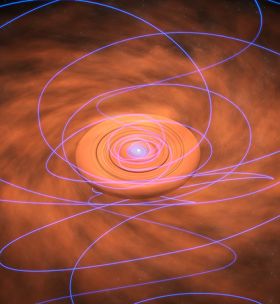 Using new images that show unprecedented detail, scientists have found that material rotating around a very young protostar probably has dragged in and twisted magnetic fields from the larger area surrounding the star. The discovery, made with the National Science Foundation's Karl G. Jansky Very Large Array (VLA) radio telescope, has important implications for how dusty disks -- the raw material for planet formation -- grow around young stars.
Using new images that show unprecedented detail, scientists have found that material rotating around a very young protostar probably has dragged in and twisted magnetic fields from the larger area surrounding the star. The discovery, made with the National Science Foundation's Karl G. Jansky Very Large Array (VLA) radio telescope, has important implications for how dusty disks -- the raw material for planet formation -- grow around young stars.
"The alignment of magnetic fields in this region near young stars is very important to the development of the disks that orbit them. Depending on its alignment, the magnetic field can either hinder the growth of the disk or help funnel material onto the disk, allowing it to grow," said Leslie Looney, of the University of Illinois at Urbana-Champaign.

